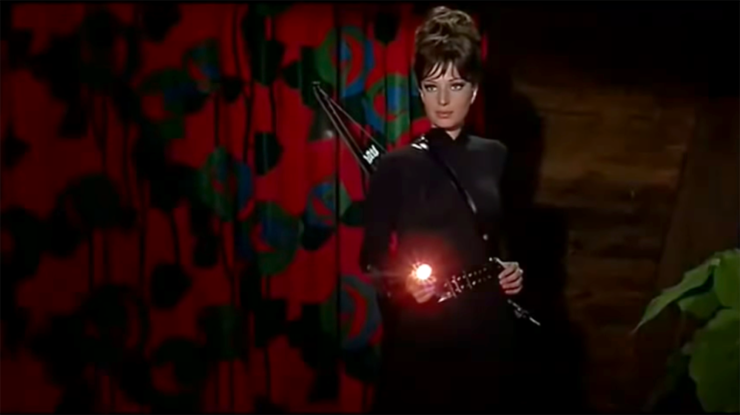British writer Peter O’Donnell created the Modesty Blaise comic strip in 1963, in part out of a desire to see a female hero who is just as capable as any of the male heroes that led most popular fiction of the day. Teaming with artist Jim Holdaway, the strip was extremely popular in Europe and around the world—pretty much everywhere except the United States. It ran until 2001.
The character was popular enough to spawn spinoffs, including a movie in 1966, an attempt at a TV series, and a 2004 movie, not to mention a series of books. None of the screen versions quite hit the mark, though…
Blaise was inspired by O’Donnell’s experiences as a soldier in the Middle East, when he encountered an orphan girl, to whom he gave a tin of food. (That experience was re-created at the top of My Name is Modesty.) When he created Blaise’s backstory, he imagined that girl he encountered being mentored by an old professor named Lob, who taught her how to read and write. She later becomes a criminal, quickly working her way up to running an international crime organization called the Network.
All that is backstory. The actual strip takes place after she has retired from the criminal life, having married an Englishman (who later dies) and moving to London. Bored with the life of the idle rich, she takes odd jobs from Sir Gerald Tarrant of the British Secret Service. Partnered with Willie Garvin, a low-level criminal whom she takes under her wing, and who becomes her best friend (but never her lover), they have tons of adventures on behalf of Her Majesty’s Government, with Garvin often using his proclivity for throwing knives, and Modesty using a mix of her sexuality and her hand-to-hand combat skills both with and without weapons. (One reason why the strip never caught on in the U.S. was its use of nudity, as one of Modesty’s signature moves was to take her top off to distract men. Ah, the 1960s…)
The strip was sufficiently popular that O’Donnell had no trouble selling the movie rights, especially to a movie industry in the UK that was eager for more spy thriller type stories in the wake of the huge popularity of the James Bond films. In an era that gave us, not only Bond, but Our Man Flint, Danger Man, The Saint, etc., Modesty Blaise seemed a perfect fit.
Buy the Book
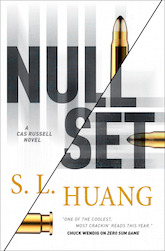

Null Set
Initially, there was to be a movie written by Sidney Gilliat, but it was never made. Later, O’Donnell wrote the first draft of a script that was filmed, but the rewrite by Evan Jones and various uncredited others (including playwright Harold Pinter) made several changes that took it farther from the comic character—most notably having Blaise and Garvin decide to become lovers (during a musical number, no less), which was one thing O’Donnell would never let happen in the strip, as he felt their platonic friendship was a cornerstone of the story.
Italian actor Monica Vitti played the title role, while Terence Stamp (previously seen in this rewatch as General Zod in the first two Christopher Reeve Superman films and as Stick in Elektra) played Garvin. Clive Revill has an entertaining dual role, playing both Gabriel’s cheapskate aide MacWhirter, and also playing Sheik Abu Tahir while wearing a ridiculous prosthetic nose. The film also stars Dirk Bogarde, Harry Andrews, Michael Craig, Alexander Knox, and Rossella Falk.
The 1966 film was not much of a hit, but it did prompt a new set of Modesty Blaise stories, as O’Donnell wrote a novelization of the film (based on his original script rather than any of the rewrites), and the book sold incredibly well. O’Donnell wound up writing a whole series of Modesty Blaise novels that were released alongside the comic strip from 1965 to 1985, plus there were two short story collections released in 1972 and 1996.
In 1982, ABC aired a one-hour pilot for a Modesty Blaise TV series that didn’t get picked up. It moved the action from London to Hollywood and re-cast both the Middle Eastern Blaise and the Cockney Garvin as Americans, played by Ann Turkel and Lewis Van Bergen, respectively. (Since this rewatch is limiting TV movies to ones that are feature-length, we’re not covering this pilot.)
Quentin Tarantino was always a big Modesty Blaise fan—John Travolta’s Vincent Vega in Pulp Fiction can be seen reading one of O’Donnell’s Blaise books—and he served as executive producer for a direct-to-home-video movie entitled My Name is Modesty, which was intended to launch a series of Blaise films. This first film focused entirely on Blaise’s backstory, as it takes place before she became a freelance agent of H.M. Secret Service, instead taking place during her time working for Henri Louche, and flashing back to her childhood.
Alexandra Staden plays Blaise, and Jaime Lannister his own self, Nikolaj Coster-Waldau plays Miklos, who matches wits with Blaise throughout the movie. Raymond Cruz plays Raphael Garcia, who’s pretty much Willie Garvin, except Latino.
Tarantino has been talking about directing a Blaise film for ages, and Neil Gaiman wrote a script treatment at one point, but nothing has come of it. The character’s lack of a pop-culture footprint in the U.S. is probably the biggest stumbling block.
“Leave the figuring to me, Willie—you might hurt yourself”
Modesty Blaise
Written by Peter O’Donnell and Evan Jones
Directed by Joseph Losey
Produced by Joseph Janni
Release date: July 4, 1966
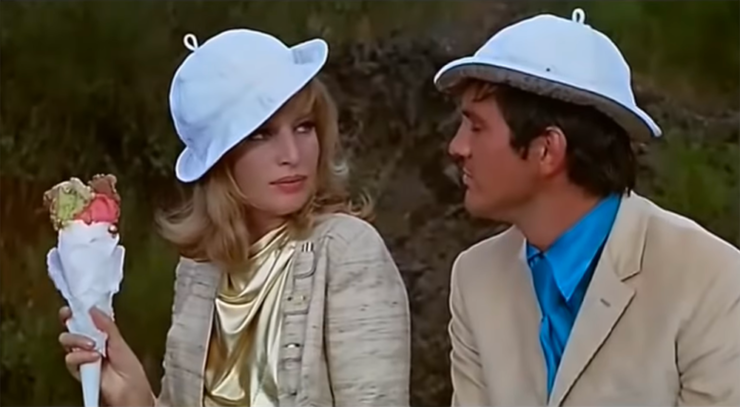
A shipment of diamonds is being sent to Sheik Abu Tahir. In order to maintain good relations with the sheik, the British Secret Service chief, Sir Gerald Tarrant, suggests having ex-criminal mastermind Modesty Blaise protect the shipment and find out who’s targeting it. The Minister is reluctant at first, but accedes, especially since the last agent they assigned to this was killed.
Gabriel, the head of a criminal empire who faked his own death, is also after the diamonds. From his compound in the Mediterranean, he is planning to steal the diamonds before they can reach the sheik. His chief enforcer, Mrs. Fothergill, is brutally training three of Gabriel’s thugs for the heist.
Blaise and her partner, Willie Garvin—whom she calls away from an assignation—travel to Amsterdam. An attempt is made on her life similar to the one that claimed the previous agent, but Garvin and Blaise manage to avoid injury.
Tarrant sets up a decoy plane to carry the diamonds, which Gabriel shoots down with a missile. Meanwhile, Blaise hooks up with a former lover named Paul Hagen, who used to be a secret agent, while Garvin hooks up with a former lover of his, Nicole. Nicole reveals that Gabriel is after the diamonds, and then is killed by Gabriel’s thugs. Blaise and Garvin take care of Nicole’s killers, then try to get Gabriel to capture them. Hagen and Blaise are captured by Gabriel’s men, also, but Garvin and Tarrant rescue them.
At one point, Tarrant has Blaise and Garvin kidnapped, as they’ve gone off book. (Blaise drugged Hagen and escaped from him, to Tarrant’s annoyance.) However, Blaise and Garvin use trick cigarette boxes to gas the cars they’re being taken in and leave.
One of Gabriel’s thieves doesn’t survive Mrs. Fothergill’s dive training, so Gabriel decides that he needs to replace him with Garvin. He kidnaps Blaise and Garvin, and forces Garvin to help steal the diamonds, or Blaise will be killed.
Tarrant’s people are watching Gabriel’s yacht, but Gabriel and the thieves are actually on a cargo ship, from which they launch a submersible and steal the diamonds. Once the heist is successful, Blaise and Garvin are brought to Gabriel’s Mediterranean redoubt and imprisoned. Gabriel offers to let Blaise go if she joins forces with him and kills Garvin—as a good-faith gesture, Gabriel offers to kill Mrs. Fothergill, also. Blaise refuses, and instead manages to escape on her own, mostly using feminine wiles. She frees Garvin, and then removes the false epidermis from his back, which contains a bunch of gadgets, most notably a radio that signals the sheik.
Blaise and Garvin fight their way to freedom, but it’s a hard road. They manage to kill Mrs. Fothergill, but the sight of her corpse galvanizes Gabriel, sending all his people after them. They’re surrounded—but then the sheik shows up and overruns the redoubt, taking Gabriel prisoner. The sheik promises Blaise anything she wants in exchange for getting the diamonds to him—and she asks for the diamonds themselves…
“You’re the boss”
My Name is Modesty
Written by Lee Batchler & Janet Scott Batchler
Directed by Scott Spiegel
Produced by Marcelo Anciano and Michael Berrow and Ted Nicolaou
Release date: September 28, 2004
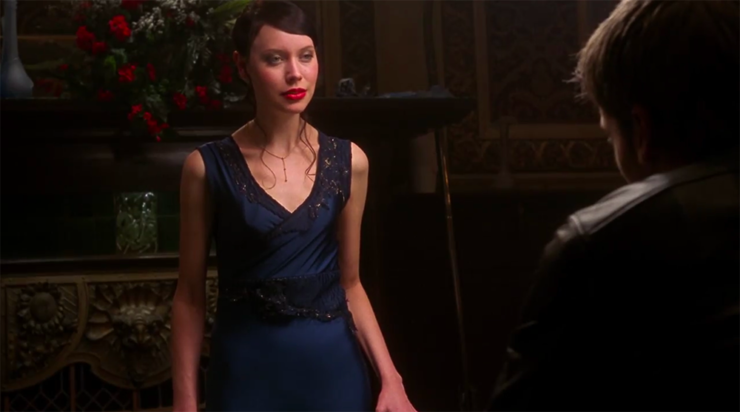
We open in the Balkans, where three soldiers are in the midst of some ruined buildings. They see a little girl, and one of the soldiers gives her a can of food.
Fifteen years later, in Tangiers, that girl is grown up and calls herself Modesty Blaise. She works for Monsieur Louche at his casino. A high roller is winning big at the roulette table so Blaise takes over for the croupier and surreptitiously switches the balls. She uses her charm to convince the gambler to keep going and she manipulates the wheel so that he loses everything. He seems unconcerned about losing, wishing Blaise well.
After the casino closes, Louche instructs one of his subordinates, Garcia, regarding a drug deal the next day. Garcia then departs for a hot date. Louche leaves not long after, but his driver takes him to an alley where he is confronted by several men with guns. Louche manages to kill the driver and two other assailants, but the leader of the group, Miklos, shoots him, refusing Louche’s offer of money. Miklos shoots him four times and then a fifth after he falls dead to the ground, so this is obviously personal.
Miklos then goes to the casino with more armed thugs, shooting up the place and taking everyone hostage. He wants access to Louche’s vault, and he kills one of the employees—who insists he doesn’t know the vault’s combination—to make his point. Blaise stands up and says that the man Miklos just killed is the only one present who knew the combination. Miklos then informs Blaise that Louche is dead.
Blaise says that the combination is on Louche’s computer, but only Garcia knows the password to the computer, and he’s very far away on a date. Miklos is frustrated—of the people with access to the vault, he’s killed two, and the other is nowhere nearby. In his anger, he shoots and wounds a bartender.
Miklos allows Blaise to call Garcia and she tells him to come down to the casino, not mentioning the armed thugs holding them hostage. However, after Garcia hangs up, he knows that Blaise is in trouble and the casino is under siege—she spoke to him in code. He leaves his (very pissed off) date behind and heads out.
Blaise informs Miklos that Garcia won’t arrive until 6am. Miklos suggests they play a game—it is a casino, after all. They go to the roulette wheel, and then they discuss stakes, since it’s not a real game of roulette if there are no stakes. Blaise points out that, while the people who play here use money, what they are actually playing for is their livelihood, their pride, their relationships, their personality, their arrogance, their lives—something precious to them. So there must be true stakes.
Miklos says that if he wins, Blaise has to tell him a story about herself. If she wins two in a row, Miklos will let a hostage go.
Blaise wins two in a row and asks that the bartender and one other person go so that he can receive medical attention—Miklos only agrees if the second hostage is an advance on her next victory, and she agrees.
When Miklos wins, Blaise tells the story of her life. She lived in a refugee camp in the Balkans, stealing food and struggling to survive. She has no memory of her parents, nor any idea where she was born or how old she is, and she didn’t even have a name.
She rescues an old man, being set upon by a bunch of other kids, who try to steal his bag. They escape the camp, stealing an Army jeep. His name is Professor Lob, and he mentors her, teaching her how to read and write, and also trains her in martial arts. They travel from town to town, Lob acting as an itinerant tutor to earn money. Their first night together, she undressed in front of him un-self-consciously, and from that point on, he refers to her as “Modesty.”
Eventually, they wind up in Algeria. They’ve earned enough to purchase papers so they can travel more openly, and he needs her to pick a last name. She chooses “Blaise,” which was the name of Merlin’s tutor in the King Arthur book that Lob used to teach her how to read.
Unfortunately, there’s a war on in Algeria, and Lob is killed. Blaise makes her way to Tangiers, and lives on the streets, picking pockets. Louche sees her there, impressed with her skill, and takes her in.
While Blaise and Miklos play roulette, one of the waitresses tries to make a run for it. She’s shot and wounded for her trouble. Miklos is furious and sick of playing games. It’s also past 6am and there’s no sign of Garcia. Blaise says that he obviously betrayed them and has left them for dead, at which point she admits that she knows the computer password, and can therefore get the vault combination. Miklos sees that now she’s scared, where she hadn’t been up until now, and he makes her say that he’s the boss.
She goes to Louche’s laptop and gets the combination. When they enter the vault, Miklos’s thugs are surprised to see a tunnel leading into the vault—and even more surprised to see Garcia with a bunch of armed thugs of his own. While Garcia takes out Miklos’s employees, Blaise herself takes down Miklos with her mad martial arts skillz, eventually subduing him and making him say that she’s the boss. Then she kicks him over a railing, and he falls on top of the roulette table, impaled on the wheel handle.
Blaise tells Garcia to clean up the mess—both the bodies and the physical damage—and to cancel the drug deal. She says to give the client $20,000 to placate them, but as of now they’re out of that business.
One of the bartenders asks how much of the story she told Miklos was true, and she smiles and says, “My name is Modesty.”
“Very sinister, Minister”
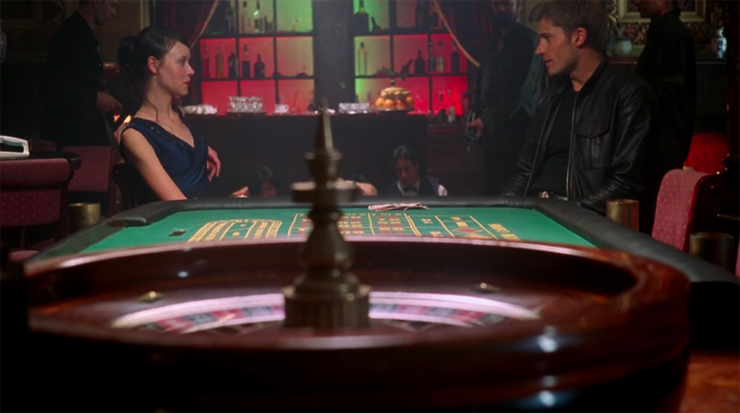
It’s funny, I’ve been telling people that I’m reviewing the two Modesty Blaise movies this week, and the reaction from most has been confusion, ignorance, and general bafflement. Blaise is one of those characters that just never hit over here to the same extent that she did across the ocean, and that’s made it hard for the character to get movie traction in the States.
The 1966 movie is a fun disaster, only partly capturing the comic strip. Visually, it’s very much a product of its time, with the bright colors, insane fashions, goofball sensibilities, and obsession with gadgets that characterized the era, particularly in this subgenre of films. (Not to mention things like Blaise and Garvin flying a plane with cigarettes dangling from their mouths and drinks in one hand while piloting with the other.) But the plot is only mildly comprehensible, and Dirk Bogarde is flaccid as Gabriel, the lack of a strong villain hurting the movie. Clive Revill as MacWhirter and especially the magnificent Rossella Falk as the psychotic Mrs. Fothergill are far stronger, but both need someone better to play off of.
Plus, the movie decides to have Garvin and Blaise become a romantic couple, which is as big a misstep as Sylvester Stallone’s Judge Dredd taking his helmet off. In fact, it’s a bigger one, since at least Dredd’s helmet removal is explainable in context (not hiding Stallone’s famous face, plus it almost works with the Dredd-is-disgraced plot). Here, there’s no reason for Garvin and Blaise to hook up; it adds nothing to the story. In fact, the moment when they decide to get horizontal is portrayed as a musical number—in a movie that hasn’t had the characters burst into song at any other point—and then it’s never followed up on. The last shot of the movie is Blaise cuddling with the sheik…
On top of that, the pacing is abysmal. The movie is only two hours long, but I felt like it went on for several ice ages. Having said that, Terence Stamp is a delight as Garvin, and Monica Vitti has an impressive physicality in the role—she slinks across the screen magnificently. And eventually, she even gets to be competent. Another of the biggest issues with this interpretation of Blaise is that—until the breakout from Gabriel’s redoubt in the climax—Blaise doesn’t really do very much. Garvin saves her from the explosive on the boat, Garvin and Tarrant save her from being captured by Gabriel’s thugs, Mrs. Fothergill gets the drop on her far too easily, and just in general she is remarkably ineffectual—until the end, anyhow, but by then it’s too late. In the strip, her sexuality was a tool in her work—in this movie, the sexuality is all there is for three-quarters of the running time.
The 2004 film suffers from a much more fundamental problem: this isn’t a Modesty Blaise movie. Yes, it provides her backstory, but that’s not what’s on the tin, as it were. Blaise stories are tales of a former criminal who has capers on behalf of the British government. My Name is Modesty is about a clever young woman who plays Scheherazade to the guy who took her boss’s casino hostage. This is useful information to have at some point—and I do like that the movie opens with a re-creation of Peter O’Donnell’s inspiration—but it’s not what you want to lead with, as that’s not what a series of Blaise films is going to be about. Her time as a criminal is part of the texture of her character and what makes her into the protagonist she is in the stories. It’s a fairly common mistake in twenty-first-century popular fiction, the obsession with backstory to the detriment of frontstory. (As an example, Star Trek: Discovery made this same mistake, as the story actually started in the third episode, with the information in the first two stuff that we didn’t need right away, but was backstory that we could get later.)
At least it gives us a good lead. Alexandra Staden is a strong, smart, capable Blaise, clever in her manipulations of Miklos, and also able to kick ass when it’s called for. I’d love to see her do the role as it’s meant to be played. Nikolaj Coster-Waldau is smarmily evil as Miklos, and Fred Pearson and Raymond Cruz do very well as Blaise’s mentor and mentee, respectively. The script has some gems—I particularly like Blaise’s colloquy on stakes when she convinces Miklos to play roulette for something—but it’s too bad that the movie pretty much feels like a movie made on the cheap over eighteen days in Eastern Europe. This is mostly because it was made on the cheap over eighteen days in Eastern Europe. This also damages the film’s attempt to be a Modesty Blaise film—whatever its (many) failures, the 1966 film looked like a big, bold Blaise adventure. My Name is Modesty is too claustrophobic.
Blaise was a strong female hero at a time when the pop-culture landscape wasn’t exactly bursting with them. There are aspects of her character that absolutely have not aged well, but it’s too bad she hasn’t gotten the film adaptation she deserves. Maybe some day…
Next week, we go from 1960s pulp to 1990s pulp, as Frank Miller and Robert Rodriguez team up to adapt Sin City.
Keith R.A. DeCandido is at MegaCon in Orlando, Florida this weekend. He’ll be at Bard’s Tower, Booth 6049, for most of the convention, selling and signing books alongside fellow authors Sherrilyn Kenyon, Brian Lee Durfee, T. Allen Diaz, Owl Goingback, and Cody Martin. He’ll also be doing a panel on writing in your own and other people’s universes on Saturday at noon with Kenyon and Karen Chance. Come by and say hi!










